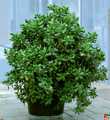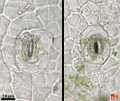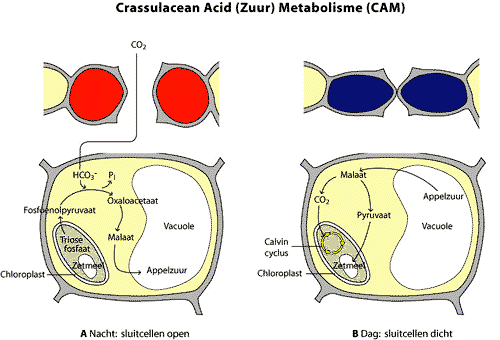To survive in a dry environment with little and irregular rainfall, succulent plants may store water in any of their body parts, i.e. leaves, stems and roots. This system is only effective with a sufficient isolation against desiccation and with a large storage capacity. Many succulents store water in the leaves. Due to the extrem size of the vacuole, the cells has a swollen appearance. There difference between palisade and spongy parenchyma is not obvious. These plants often show a specific adaptation mechanism in their metabolism, called Crassulacean Acid Metabolism (
). The various adaptations are connected and mutually reinforce their adaptive value.
A well known succulent is the pot plant Jade plant, Crassula ovata.
| Succulents: example Jade plant (Crassula ovata) |

Crassula ovata |

Upperside leaf |

Underside leaf |

Cross-section of the leaf |

Close-up of the lower tissue layers |

Small vein between mesophyll cells |

Tannin cell in the mesophyll |

Epidermis strip with stomata and edgy fragments of the waxy layer |

Opened and closed stomata |
| CAM plants |
 |
To survive in a dry environment with little and irregular rainfall, succulent plant may store water in any of their body parts, i.e. leaves, stems and roots. This system is only effective with sufficient isolation and with a large storage capacity.
These plants often show specific adaptations in their metabolism (CAM metabolism).
The various adaptations are connected and mutually reinforce their adaptive value.
To prevent water loss, the stomata of these plants are closed by day, to open only at night when temperature decreases and humidity rises. Since the absorption of CO2 is only possible at night, CO2 storage and changes in metabolism are necessary to carry out photosynthesis by day.
At night CO2 is stored as malate in the large vacuoles, to be released for photosynthesis by day.
This mechanism was discovered first in Crassulacean plants, such as Crassula and therefore is called Crassulacean Acid (acid: malate) or CAM Metabolisme.
This type of metabolism appeared to occur not only dicot plants, but also in a number of monocots, among others the crop pineapple and the pot plant Sanseveria.